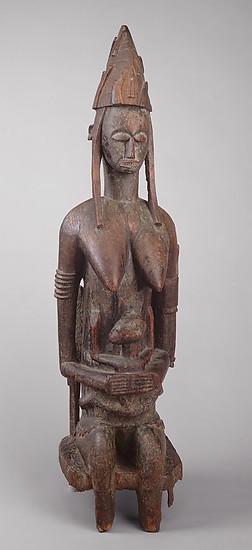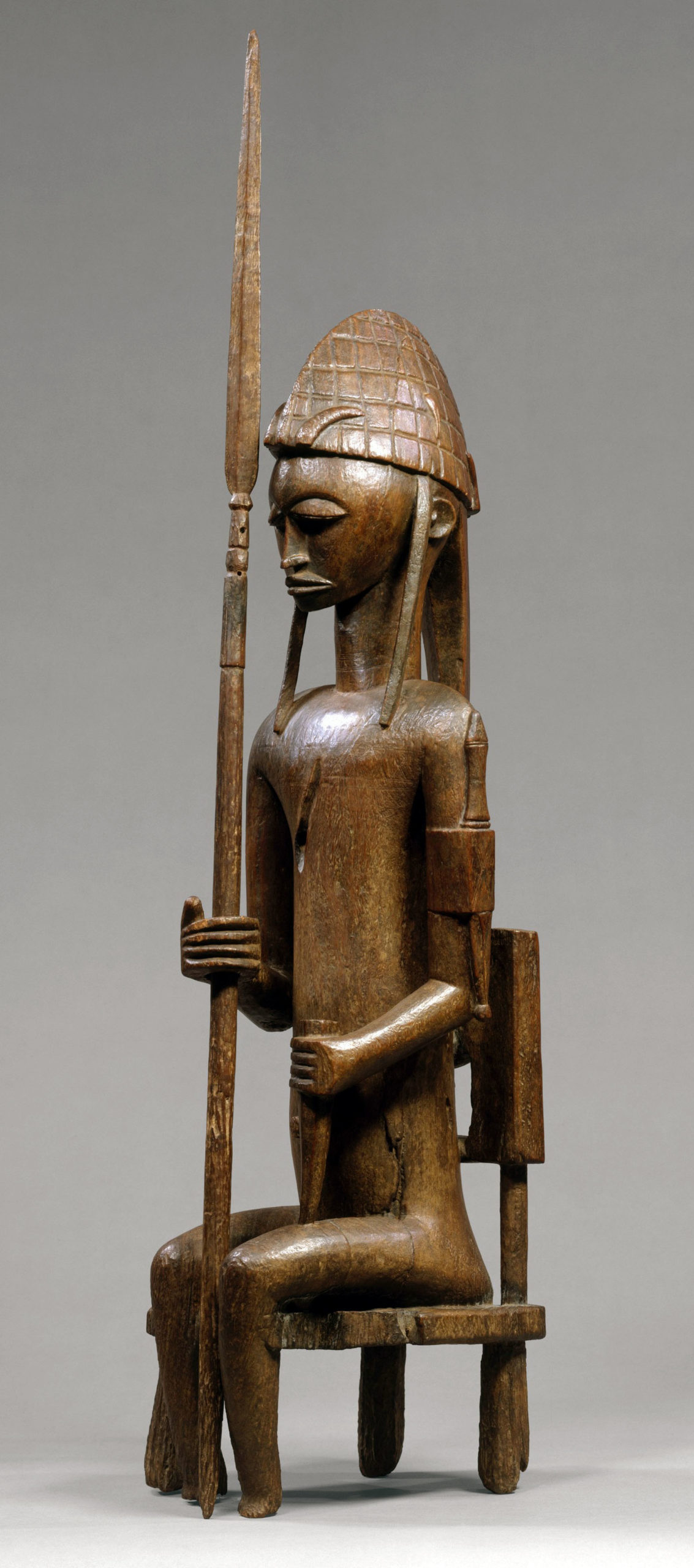
Mother and Child (Gwandusu), 15th–20th century, Mali, Bougouni or Dioila region, Bamana peoples, wood, 123.5 x 36.6 x 36.5 cm (The Metropolitan Museum of Art)
The large, naturalistic figures of a woman and man shown here are associated with Jo, a society of initiated Bamana men and women found primarily in southern Mali, near the towns of Bougouni and Dioila. They are also used in Gwan, a division of Jo concerned with women’s fertility and childbirth. Now displayed together in The Metropolitan Museum of Art’s collection, each of these figures originally came from a different community where they were paired with mates of their own size.
Each of these works embodies complementary Bamana ideals of physical beauty and moral character.
Gwandusu
The seated mother with child is referred to as Gwandusu, a name evoking strength, passion, and conviction. It combines Gwan, the name of the organization itself that also means hot, hard, or difficult, and dusu, which translates as soul, heart, passion, courage, and anger.
She is represented as both a nurturing mother and a female with extraordinary powers. Her heavy breasts hold the promise of milk for the child that clings to her abdomen. On her head is a hat decorated with amulets in the form of small animal horns filled with ritual ingredients, and strapped to her left arm is a dagger. Both the knife and hat are commonly associated with powerful male hunters: their representation here underscores the exceptional nature of this ideal woman.
Gwantigi
The male figure is called Gwantigi, or “Master of Gwan.” He is identified as a hunter and wears an amulet-laden headdress and a dagger on his arm. He is represented seated on a chair, an indication of his status as a leader. The lance he holds in his raised right hand confirms his power and authority.
A range of associations

Seated Male with Lance (Gwantigi), 15th–20th century, wood, Mali, Bamana peoples, 89.9 cm high (The Metropolitan Museum of Art)
Jo and Gwan sculptures demonstrate a range of gestures and attributes that suggest a possible link to the terracotta statuary of the Inland Niger Delta region. These two sculptures are probably not the work of the same artist, although they are quite similar stylistically. Note their long, massive torsos with wide, arching shoulders, and exaggerations of the human figure that emphasize their power. Their faces are thin and tapered, with large, heavy-lidded eyes, a slender nose, and sharply projecting lips. Represented as archetypes of humanity, they embody Bamana ideals of male and female social roles that, while distinct, are considered equally important in Bamana society.
Jo and Gwan sculptures are cared for by senior members of the associations and displayed as part of a sculptural ensemble during annual festivals. Prior to their public presentation, the sculptures are cleaned, oiled, and adorned with clothing. Annual displays organized by Jo typically involve only a pair of male and female figures. Those of the Gwan association are more elaborate, and may include up to seven figures in their grouping. Impressive in size and infrequently displayed, the sculptures evoke wonder during their annual presentations and are described by some Bamana as “extraordinary and marvelous things.”
Dating
The wood from which these sculptures are carved has been dated as early as the fifteenth century by radiocarbon analysis, which measures the amount of radioactive decay of carbon found in organic material. Wood is a perishable medium subject to damage in a warm, moist climate or by the ravages of insects. The unusually well-preserved condition of the figures is largely due to the arid conditions of the region in which they were found.
© 2006 The Metropolitan Museum of Art, New York (by permission)

